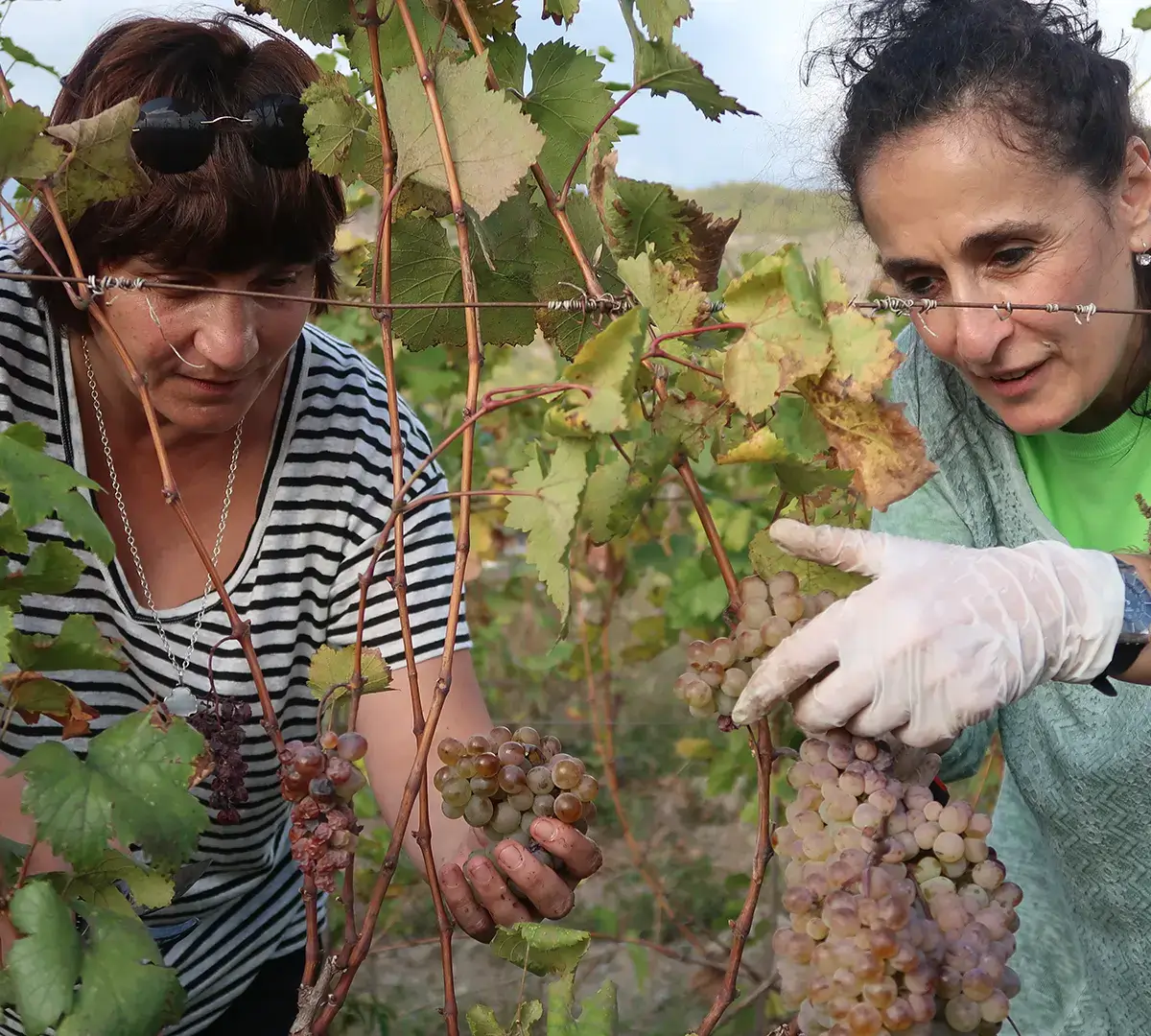Our Winemaking Process
Our "Niniani"qvevry red wine is handcrafted in Georgia's Kakheti region using traditional methods, indigenous grapes Saperavi and aged in clay qvevri. The 2023 vintage was carefully harvested, fermented, bottled, and exported to Germany, with full certification and EU-compliant labeling.
Our vineyards are located in eastern Georgia, in the Kakheti region, in the villages of Kondoli, Napareuli, and Tsinandali in the Telavi district. Our vineyards are cared for throughout the year by specially selected local farmers - whose families have centuries-old traditions of vine cultivation and winemaking. With our intensive control and monitoring, they help us in the wine production process.
What sets Georgia apart is its unique winemaking method using qvevri - large, egg-shaped clay vessels buried underground. This technique, passed down through generations, is still in use today and was recognized by UNESCO as an Intangible Cultural Heritage of Humanity. The qvevri method allows wine to ferment and age naturally, creating a rich, authentic taste deeply connected to the earth and tradition.
For our wine "Niniani", we use the Georgian indigenous red grape variety called Saperavi for red wine and Rkatsiteli for white/amber wine. The name Saperavi reflects a distinctive characteristic of the grape - it comes from the Georgian word meaning "to color," referring to the grape's intensely dark, nearly black skin, which is rich in natural pigments. Because of this deep color, Saperavi wine is often referred to in Georgia as "black wine."
Among red grape varieties worldwide, Saperavi is considered highly valuable due to its exceptional agricultural and winemaking qualities - such as producing high-quality wine, being high-yielding, frost-resistant, adaptable to different environments, and rich in both sugar and pigment. For these reasons, experts often regard Saperavi as one of the finest grape varieties in the world for crafting red wine.
In Kakheti, Georgia's renowned wine region, grapes are typically harvested in autumn - specifically in September. Our 2023 Saperavi vineyard harvest also took place in September.
The grape harvest holds special meaning for us. It is a celebration of the harvest and a time of joy and togetherness with family, relatives, and friends. The experience culminates in the pressing of the grapes, placing the juice into qvevri, and sharing a traditional Georgian feast with music and song.
The freshly picked grapes were pressed in a family-owned marani (wine cellar) located in the village of Tsinandali, in the Telavi district, at the foot of the beautiful Caucasus Mountains. The resulting grape juice, along with the skins and seeds, was placed into historic clay qvevri - large amphorae buried deep underground - in a traditional marani located beneath the home of our local partner family.
To ensure proper fermentation, the grape must had to be stirred 3 to 4 times a day using a special long wooden paddle during the early stages. The natural fermentation process in the qvevri lasted about 2 to 3 weeks.
Once fermentation was complete, the qvevri were sealed hermetically. We did not open them for about six months, allowing the young Saperavi wine to rest and develop naturally with the skins and seeds through the 2023-2024 winter, without any interference.
In March 2024, we reopened the qvevri. Inside, we found our new wine - deep red, almost black in color, naturally filtered, and crystal clear.
After tasting the wine, we carefully separated it from the grape skins and seeds settled at the bottom (known in Georgia as "chacha", which is also used to make the famous Georgian spirit often compared to Italian grappa). The wine was then transferred into cleaner, smaller qvevri, sealed again, and left for a few more months to continue its natural clarification process.
About 3-4 months later, in late summer 2024, we opened the qvevri once more. Our wine was ready to be bottled. Opening the qvevri, just like the harvest and grape pressing, holds special significance for us.
Our family, friends, and loved ones take part in these meaningful moments. Receiving the wine that was pressed the previous year and tasting it for the first time during the opening of each qvevri is always a joyful celebration for us.
In order to bottle and sell our wine - and to obtain the necessary permissions for export to Germany and across the European Union - we were required to conduct a full chemical and laboratory analysis of our wine through the National Wine Agency of Georgia, a government regulatory body.
This analysis was carried out in accordance with both national and international standards, including those of the European Union. Based on the results of the laboratory testing, the characteristics and quality indicators of our wine were confirmed to be high. As a result, we were officially granted the certification and legal authorization to bottle, label, and export our wine.
Our wine officially is manufactured, bottled and exported by my company EMC, LLC (Evaluation and Management Consulting), operating in Georgia and internationally which I have established in 2008. In 2024 it started new line - wine production and exporting. For more information about EMC, please find https://emc-int.com. As for the selling it in Germany and in EU, company of my husband - Sannecke GmbH will be your official partner. For more information please see https://sanneck.com.
For bottling our unique wine from the 2023 harvest, we chose a manual bottling method, just as we did throughout every stage of the process described above. We used 0.75-liter dark-colored bottles and sealed them with high-quality natural cork stoppers. Together with our local partner family and additional helpers, we personally bottled the wine by hand. After corking the bottles, to ensure the long-term preservation and airtight sealing of the wine, we also applied a special wax coating - hand-dipped wax caps over the corks - adding both extra protection and a traditional touch to each bottle.
The concept, design, and production of the wine labels for our bottled wine were all carried out by our family members. Specifically, the idea and design were created by our daughter, while the technical execution was done by my brother, a graphic designer. The labels include essential information such as the alcohol content, harvest year, bottling date, and more. Additionally, in compliance with European Union regulations, we included a QR code on the label, which provides further details about the wine's characteristics and composition.
After the export and transportation of our wine from Georgia to Germany, it was stored in a specially prepared wine cellar and storage space located in our historic family house in a village in Lower Saxony. Our cellar maintains the optimal climate and stable temperature year-round - both in winter and summer - ensuring ideal conditions for wine preservation. When our wine is sold, it is delivered directly from this cellar to the buyer.














